- There are no more items in your cart
- Shipping Calculated at checkout
-
Sub-Total (inc. VAT)
£0.00
Need Help?
Radiator Paints
Transform your radiators from overlooked fixtures into stylish design elements, with specialist radiator paints. Whether you're refreshing a home, office, school, or hospitality space, these paints offer more than just colour - they provide durable protection tailored to the unique demands of radiators. Available in over 110 colours, you’re no longer limited to standard white or black. Designed to withstand high temperatures and everyday use, specialist radiator paints ensure a long-lasting, vibrant matt, satin, or gloss finish. Choose a shade to either seamlessly blend your radiators with your painted walls or make them stand out as eye-catching features.
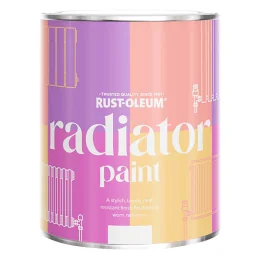
Rust-Oleum Radiator Paint
Radiator paint available in various colours including white, grey, and anthracite. Durable matt, gloss or satin finish. For previously painted or primed radiators. Withstands high temperatures up to 60°C. Mould and algae resistant. Water-based formula with virtually no odour, making it safe for indoor use. Non-yellowing.

Coo-Var Radiator Enamel
White water-based acrylic polymer enamel. Satin or mid-gloss finish. For domestic hot water radiators. Low VOC. Quick drying.
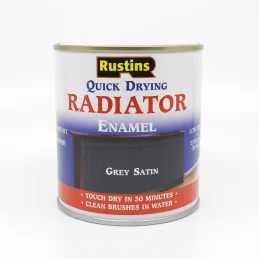
Rustins QD Radiator Paint
A rapid-drying, heat resistant water based paint, ideal for use on fridges, radiators and other white appliances. Not for use on oil-filled electric radiators. Heat resistant & low odour Does not yellow Available in gloss & satin finishes
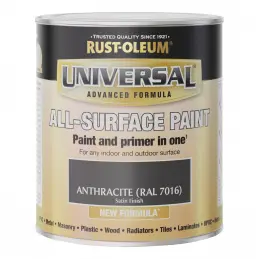
Rust-Oleum Universal All Surface Paint - Brush Grade
In 11 Colours. Satin, gloss or matt finish depending on colour choice. Universal paint for multiple surfaces including wood, metal, and ceramics. Can be applied on wood, metal, most plastics, ceramics, and even rust. No primer needed.Excellent adhesion and durability.
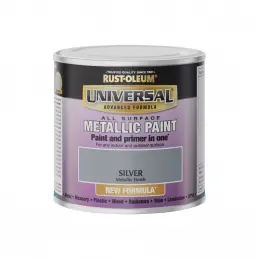
Rust-Oleum Universal All Surface Paint Metallic - Brush Grade
In metallic gold, silver or copper. For adding a metallic finish to a variety of surfaces. Can be applied to wood, metal, most plastics, ceramics, and even rust. No primer needed. Highly durable with a long-lasting finish.
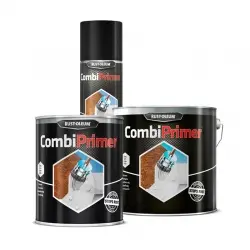
Rust-Oleum 3369/3380 CombiPrimer Anti-Corrosion
Available in grey and red, can or aerosol. Two-pack anti-rust primer for new or slightly rusted surfaces. For steel surfaces, provides and enhance protection against corrosion. Recoatable after 2 hours; fast drying and lead- and chromate-free. 5-year shelf life if stored properly.
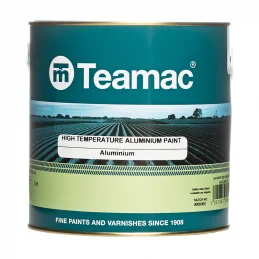
Teamac High Temperature Aluminium Paint
Aluminium-coloured satin enamel paint. For surfaces exposed to indirect heat up to 450°C Ideal for fire surrounds, radiators, hot pipes, and other high-temp areas. High durability and heat resistance.
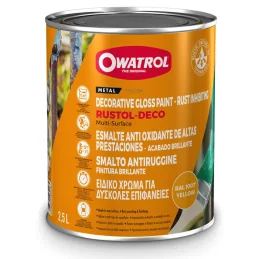
Owatrol Rustol-Deco All-Surface Decorative Paint
Rust inhibiting primer and finish in one for new or rusted metal, in 10 gloss colours. Apply direct to rusted surfaces. Fencing, railings, garden furniture, porches, various metal structures, doors, frames, radiators, pipes, machinery, tiles and more. Can also be used on plastic, uPVC and wood, and horizontal and vertical surfaces. Heat...
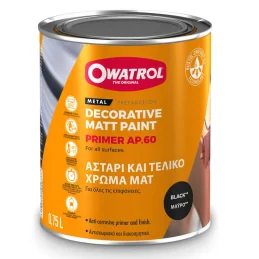
Owatrol AP60 Anti-Corrosive Primer
Exceptional anti-corrosion protection and weather resistance for new or rusted metal, in 4 colours. For ferrous and non-ferrous metals – galvanised, aluminium, zinc, copper and more. Fencing, railings, garden furniture, porches, various metal structures, doors, frames, radiators, pipes, machinery, tiles and more. Can also be used on...
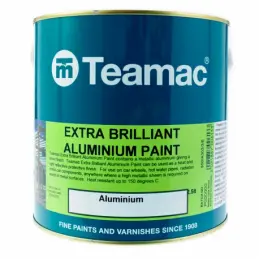
Teamac Extra Brilliant Aluminium Paint
High sheen aluminium finish. Heat and light reflective paint. For car wheels, radiators, hot water pipes, and metal components where a durable and reflective finish is required. Heat resistant up to 150°C. Internal and external use.
Need Help?
Need Help?
Why Choose Specialist Radiator Paints?
Specialist radiator paints offer more than just a colour change for your heating units; they provide a comprehensive solution to the unique demands radiators face. Unlike regular emulsion paints, these paints are specifically designed to withstand high temperatures, frequent thermal cycling, and environmental conditions that standard paints cannot endure. By painting radiators using specialist radiator paints, you not only enhance the aesthetic appeal of your radiators but also ensure they remain functional and attractive for years to come. CHoosing a specialist radiator paint is the superior option.
1. Superior Thermal Adaptability
Radiators continuously cycle through heating and cooling, which causes the metal to expand and contract. Regular paints tend to crack or peel under such conditions due to their inability to adapt to these thermal changes. Specialist radiator paints are formulated to be highly flexible, allowing them to expand and contract along with the radiator. This flexibility prevents cracking and peeling, ensuring a long-lasting, smooth finish that maintains its integrity over time.
As the saying goes; buy cheap, buy twice. Using specialist radiator paints and applying them properly ensures you’ll only do the job once.
2. Enhanced Finish Quality
Standard paints can often leave brush marks or an uneven finish, particularly on metal surfaces like radiators. Specialist radiator paints are designed to level out naturally, resulting in a smooth, even finish whether applied with a brush, roller, or spray. This self-levelling property ensures a professional-looking result with minimal effort, making it possible for even DIY enthusiasts to achieve a flawless finish.
3. Comprehensive Surface Protection
Beyond just providing colour, specialist radiator paints also protect the surface of the radiator itself. Many of these paints include rust-inhibiting properties, which are essential for metal radiators, especially in humid environments like bathrooms or kitchens. By forming a protective barrier against moisture and corrosion, they help extend the lifespan of the radiator, reducing the need for maintenance or replacement.
4. Quick and Efficient Application
Specialist radiator paints often come in formulations that dry quickly, allowing for rapid project completion. Quick drying times mean that radiators can be back in use sooner, which is particularly beneficial in commercial or institutional settings where heating downtime must be minimised. This efficiency also reduces the risk of dust or debris settling on the freshly painted surface, resulting in a cleaner finish.
5. Non-Yellowing Formula
A common issue with painting radiators using standard paints is yellowing over time due to heat exposure. This can make the radiator look aged and unattractive. Specialist radiator paints are specifically designed with non-yellowing properties, preserving the paint's original colour even after prolonged exposure to high temperatures. This feature is particularly important for light or white-coloured paints, where yellowing would be most noticeable.
6. Versatile Use in Varied Environments
Radiators are found in a wide range of settings, from residential homes to commercial spaces, schools, and public buildings. Specialist radiator paints are formulated to meet the needs of all these environments. For example, in a school or hospital where hygiene is crucial, these paints offer a durable, easy-to-clean surface that can withstand frequent wiping and disinfecting. In a home, they offer aesthetic versatility, enabling radiators to match or complement interior decor seamlessly.
7. Washable and Easy to Clean
Standard paints can be challenging to clean without damaging the finish, especially if they are not formulated for high durability. Specialist radiator paints have matt, satin, and gloss finishes that are designed to be washable, allowing for easy removal of dust, dirt, and even marks from everyday contact. This feature is particularly useful in high-traffic areas or in homes with children and pets, where maintaining a clean appearance is essential.
8. Low Odour and Low VOCs
Painting indoors can often lead to strong, lingering odours, especially with standard paints that may contain high levels of volatile organic compounds (VOCs). Many specialist radiator paints are formulated to be low odour and have reduced VOC content, making them safer and more comfortable to use indoors. This is an important consideration for spaces that need to be occupied soon after painting, such as homes, schools, or offices.
9. UV Resistance for Longevity
Radiators located near windows or in areas with lots of natural light can suffer from UV exposure, which causes standard paints to fade over time. Specialist radiator paints often include UV-resistant properties, ensuring the colour remains vibrant and true even with prolonged sunlight exposure. This resistance is crucial for maintaining the radiator’s appearance, particularly in rooms where the radiator serves as a key design element.
10. Compatibility with Various Radiator Types
Not all radiators are created equal, and they come in various designs and materials such as steel, cast iron, and aluminium. Specialist radiator paints are versatile enough to be used on a wide range of radiator types, including single and double-panel convector radiators, towel radiators, column radiators, and more. This compatibility ensures that regardless of the radiator's style or construction, there is a specialist paint suited to the task.
11. Huge Colour Range
With brands like Rust-Oleum offering over 110 colours, specialist radiator paints provide exceptional options for custom shades. Radiators can be transformed from dull and purely functional units into stylish elements that either blend in or stand out. This customisability allows homeowners and designers to create unique looks, whether by matching the radiator to the wall colour for a seamless appearance or using a bold hue to make a statement.
12. Ease of Use for DIY Projects
Specialist radiator paints are formulated to be user-friendly, making them accessible for DIY enthusiasts and professionals alike. Many come in formats that require no primer, can be applied directly to the radiator, and offer simple cleanup with soap and water. This ease of use makes it possible to achieve a high-quality finish without the need for extensive preparation or specialised equipment, saving time and effort.
13. Enhanced Safety and Compliance
In settings where safety standards are a concern, such as schools, healthcare facilities, or public buildings, specialist radiator paints offer peace of mind. Some formulations include fire-retardant properties or meet specific safety regulations, adding an extra layer of protection. This makes them a preferred choice for environments where compliance with safety standards is paramount.
14. Low Maintenance Over Time
Once applied, specialist radiator paints require minimal maintenance to keep looking their best. Their durable, washable surfaces mean that they can be kept clean with a simple wipe-down, and their resistance to chipping and peeling reduces the need for touch-ups. This low maintenance aspect is particularly advantageous in commercial or public settings, where upkeep must be efficient and cost-effective.
Types of Radiators That Can Be Painted
Specialist radiator paints are incredibly versatile and can be used on a wide array of radiator types, each with its own unique characteristics and aesthetic potential. By using these paints, radiators can be transformed to match or enhance the design of any space. Here's an in-depth look at the different types of radiators and how they can benefit from a coat of specialist paint:
Single and Double-Panel Convector Radiators
Single-Panel Convector Radiators
These are the most common radiators in UK homes, known for their slim profile and efficient heating. They consist of a single panel with convector fins behind it that enhance heat emission. Despite their functional design, they often lack visual appeal, especially if left in their standard white finish. Using specialist radiator paints, homeowners can easily customise these radiators to blend with the room's decor. A single-panel radiator painted to match the wall colour can create a seamless look, making the room appear more spacious. Alternatively, using a bold colour can turn it into a feature that adds interest to an otherwise plain wall.
Double-Panel Convector Radiators
These are similar in design to single-panel convectors but include an additional panel and set of fins, offering greater heat output. While efficient, they can be visually bulky. Painting a double-panel radiator in a shade that complements the room's furnishings can help it integrate better with the overall design. The increased surface area of double-panel radiators also means they have a more prominent visual impact, making the choice of colour and finish even more significant. A satin or gloss finish can enhance their modern appeal, while a matte finish can offer a more understated, elegant look.
Towel Radiators
Towel radiators, commonly found in bathrooms and kitchens, serve the dual purpose of heating the room and drying towels. They come in a range of designs, from simple ladder styles to more elaborate shapes.
Painting towel radiators can add a touch of luxury to the bathroom. For a spa-like ambience, consider using soft, neutral colours that evoke a sense of calm and relaxation. Alternatively, a towel radiator painted in a metallic finish, such as silver, gold, or bronze, can add an element of sophistication and complement other bathroom fixtures. In kitchens, a brightly coloured towel radiator can bring a playful pop of colour to the space, coordinating with kitchen accessories or cabinetry.
Due to their location in high-moisture areas, these radiators are susceptible to rust and discolouration if not properly protected. Choosing a specialist radiator paint with moisture resistance ensures the radiator maintains its appearance over time - but be sure to check beforehand as not all radiator paints are suitable for use on towel radiators.
Column Radiators
Column radiators are known for their classic, vintage look and are often found in older homes and period properties. They feature a series of vertical columns that provide excellent heat output and a distinct aesthetic appeal. The traditional design of column radiators makes them a perfect candidate for specialist radiator paints, which can highlight their intricate details and enhance their visual impact.
These radiators offer a wonderful opportunity to incorporate bold colours or metallic finishes into a room. A column radiator painted in a deep, rich hue such as navy, burgundy, or forest green can become a striking focal point in a living room or hallway. For a more understated look, painting the radiator in a soft, muted tone like dove grey or pastel blue can add a touch of elegance without overwhelming the space. In rooms with a vintage or industrial theme, a metallic finish such as brass or copper can accentuate the radiator’s design, giving it an authentic, period-appropriate appearance.
Vertical Radiators
Vertical radiators are a modern, space-saving solution, ideal for rooms with limited wall space or awkward layouts. Their tall, narrow design allows them to be installed in areas where traditional horizontal radiators wouldn’t fit, such as between windows or on narrow wall sections. Vertical radiators come in various styles, from flat panels to tubular designs, making them a versatile option for both contemporary and traditional interiors.
Painting vertical radiators can transform them into eye-catching design elements. In a modern interior, using a bold, contrasting colour like black, red, or cobalt blue can create a dramatic, statement piece that draws the eye upward, enhancing the room’s sense of height. For a more subtle approach, painting the radiator in a shade that matches the surrounding wall or woodwork can help it blend in while still providing a sleek, finished look. Vertical radiators in metallic finishes, such as brushed nickel or chrome, can add a touch of sophistication and reflect light, making smaller spaces feel brighter and more open.
Horizontal Radiators
Horizontal radiators are the most traditional choice and are typically found under windows to counteract the cold air entering through the glass. While functional, they can be visually unremarkable if left in their standard finish. Specialist radiator paints allow homeowners to either camouflage these radiators or turn them into decorative features.
Painting a horizontal radiator in a colour that matches the wall creates a cohesive, streamlined look that can make the room feel more unified. This technique is particularly effective in rooms with a neutral colour scheme, as it allows the radiator to disappear into the background, maintaining the focus on other design elements such as furniture or artwork. For those who prefer to make a bolder statement, a brightly coloured horizontal radiator can add a burst of colour and personality to the space. In children's rooms, for example, painting the radiator in a playful shade like turquoise or coral can create a cheerful, inviting atmosphere.
Flat Panel Radiators
Flat panel radiators are a popular choice for modern and contemporary interiors due to their minimalist design and sleek, smooth surfaces. They are available in both vertical and horizontal orientations and can be a subtle yet effective heating solution that doesn't dominate the room’s aesthetic. However, their understated design provides an excellent canvas for creativity with specialist radiator paints.
Painting flat panel radiators in a high-gloss finish can enhance their modern appeal, reflecting light and adding a sense of depth to the room. For a more understated look, a matte or satin finish in a neutral tone can help the radiator blend seamlessly with the surrounding decor. If the room's design calls for a statement piece, using a bold colour like emerald green, mustard yellow, or deep plum can turn the radiator into a focal point. Flat panel radiators can also be painted in metallic finishes for an ultra-modern, high-end look, complementing other metal elements in the room such as light fixtures or hardware.
Cast Iron Radiators
Cast iron radiators are a hallmark of historic and period properties, known for their durability, heat retention, and ornate designs. Their robust construction and classic appearance make them a standout feature in any room, but they can often appear dated if left in their original, worn finish. Specialist radiator paints are perfect for revitalising cast iron radiators, protecting them from rust while enhancing their detailed features.
When painting cast iron radiators, consider using colours that highlight their vintage charm. Deep, rich shades like burgundy, navy, or charcoal can add an element of sophistication and drama, making the radiator a focal point in the room. For a more traditional or antique look, metallic finishes such as brass, bronze, or pewter can accentuate the intricate patterns and detailing, giving the radiator an authentic, period-appropriate appearance. In modern settings, painting a cast iron radiator in a sleek, contemporary colour like matte black or soft grey can provide a striking contrast against light walls, blending old-world charm with modern design sensibilities.
Chrome Radiators
Chrome radiators are often chosen for their sleek, polished appearance, commonly found in modern bathrooms and kitchens. They add a touch of elegance and reflectivity to the space, often complementing chrome fixtures and fittings. They are typically left in their natural chrome finish as it is a difficult surface to adhere to. Using a specialist paint can offer an opportunity to add a unique twist to their appearance.Always check the manufacturer’s data sheet to ensure that your chosen radiator paint can adhere to chrome - or contact Rawlins Technical for advice.
Common Uses for Specialist Radiator Paints
Home Renovations
Radiator paints are essential for home makeovers, allowing radiators to match updated decor. With a wide range of colours, like the 110+ Make It Yours shades by Rust-Oleum, radiators can either complement the new design or stand out as accents. These paints endure high temperatures, ensuring a long-lasting finish.
Interior Design Projects
Radiator paints enable designers to seamlessly integrate radiators into room designs. A matte black finish can add industrial style, while bold colours can enhance a child's playroom. Various finishes, from metallic to gloss, help radiators match the room’s decor.
Restoring Old Radiators
Ideal for period properties, radiator paints restore the appearance of old radiators, protecting them against rust. Restoring cast iron radiators with specialist paints highlights intricate details, preserving historical charm.
Customising Rental Properties
Tenants can personalise their spaces with radiator paints, choosing colours that suit their decor. These paints can be easily painted over when moving out, making them perfect for renters wanting a reversible and landlord-friendly option.
Commercial Spaces
In offices, restaurants, and retail spaces, radiator paints can align radiators with the interior theme, enhancing the customer experience. Durable and heat-resistant, these paints keep radiators looking professional, even with frequent use.
Educational and Public Institutions
Radiator paints in schools and libraries add vibrancy and help demarcate spaces. Bright colours engage young learners, while neutral tones in libraries create a cosy atmosphere. Low-odour, low-VOC paints ensure safety in public environments.
Bathroom and Kitchen Upgrades
Radiator paints allow radiators to blend into bathroom and kitchen designs. They can match or contrast with the room's palette, and their moisture-resistant properties ensure durability in humid conditions.
Showrooms and Display Homes
Painted radiators in showrooms and display homes create cohesive and aspirational environments. Matching radiator colours to cabinetry or decor elements enhances the illusion of fully realised spaces, helping buyers envision customisable homes.
Hospitality Industry
Hotels and rental properties benefit from painted radiators that enhance the room's theme. In guest rooms, calming neutrals or bold colours create memorable designs. These paints offer a durable, easy-to-clean finish suitable for busy hospitality settings.
Healthcare Facilities
In hospitals and clinics, radiator paints improve aesthetics, contributing to a calming environment. Soft colours reduce patient anxiety, while durable, low-VOC paints ensure cleanliness and safety.
How To Paint A Radiator
Rust-Oleum’s Radiator Paint is an excellent choice for updating and safeguarding your radiators. Its highly durable, smooth finish not only improves the appearance of your radiators but also adds a strong protective layer. Available in 110+ colours including white, grey, and anthracite, it suits any interior style. Here we cover how to paint your radiators, using Rust-Oleum’s application guide:
Step 1. Preparing Your Radiator For Painting
Ensure that your radiator has been switched off and allowed to cool to room temperature. Be sure to lay down sheets to protect your floors and skirting boards from paint drips. Use masking tape to prevent paint splashes on valves and pipes.
Begin by thoroughly cleaning the surface to ensure it is free from dust, grease, and any other contaminants. The surface must also be completely dry before starting.
Step 2. Priming Your Radiator
For bare metal surfaces, it's crucial to apply a suitable metal primer to prevent rust and ensure proper adhesion of the paint. Rust-Oleum 3369/3380 CombiPrimer Anti-Corrosion is a great choice of radiator primer for its heat resistance. It is conveniently available in a 750ml tin or a 400ml aerosol, which are ideal sizes for smaller projects such as painting radiators.
If the surface has been previously painted or retains the original factory finish, it can be lightly abraded using fine sandpaper to create a slightly rough texture for better paint adherence. After abrading, degrease the surface to remove any residual oils or sanding dust.
If the previous paint is uneven or chipped, you may be able to spot prime the surface to fill in these imperfections. Rawlins Technical are always on hand by phone, email, or live chat to advise on application and preparation techniques.
Step 3. Painting Your Radiator
Stir the paint thoroughly to ensure even consistency.
The product can be applied using a brush or a roller. If you choose to use a roller, opt for a short to medium nap mohair roller to achieve a smooth finish.
Apply the paint in two coats for optimal coverage and durability.
The ambient temperature during application and drying should be maintained between 10°C and 25°C to ensure the best results.
Step 4. Using Your Radiator
The paint will be touch dry within 1 hour, allowing you to handle it lightly if needed.
It will reach a hard dry state in 4 hours, at which point it will be more resilient to handling. You can apply a second coat after the initial 4 hours of drying time.
After applying the final coat, wait at least 4 hours before turning the radiator back on. When you do turn it on, start at a low heat setting for 2 hours to allow the paint to fully cure. After this, you can gradually increase the radiator's temperature to normal operating levels.
FAQ’s
Is it necessary to turn off the heating before painting a radiator?
Absolutely. The radiator should be completely turned off and cool to the touch before you start painting. Painting a warm radiator can cause the paint to dry unevenly, leading to a patchy or streaky finish.
Do I need to sand the radiator before painting?
It's typically recommended to lightly sand the radiator to remove any rust, flaking paint, or rough areas. This ensures a smooth surface for the new paint to adhere to. Use fine-grit sandpaper and wipe down the radiator with a damp cloth afterward to remove any dust.
How many coats of paint will I need?
Typically, two coats of specialist radiator paint are sufficient to achieve a smooth and even finish. However, this can vary depending on the colour and type of paint used. Always follow the manufacturer's instructions for the best results, and allow adequate drying time between coats.
Is primer necessary before applying radiator paint?
Most specialist radiator paints are formulated for direct application onto previously painted metal surfaces, but may require a primer for bare metal. If the radiator has rust or an uneven surface, applying a suitable radiator primer can enhance adhesion and ensure a more durable finish.
Will painting a radiator affect its heat output?
When applied correctly, specialist radiator paints are thin enough not to affect the radiator’s heat output. However, it's important to avoid applying too many layers, as this could potentially reduce the radiator's efficiency.
Should radiator paint be gloss or matt?
Radiator paints were traditionally available in satin or gloss finishes, but modern specialist paints such as Rust-Oleum Radiator Paint now offer a full range from matt to gloss, with a wide variety of colour options. Gloss finishes are generally recommended for easier cleaning, though matt finishes in specialist radiator paints are also washable.
Do I need to remove a radiator from the wall to paint it?
No, you don't need to remove the radiator from the wall to paint it. You can paint it in place as long as you have good access to all surfaces. Make sure the radiator is turned off and cool before you start. Protect the surrounding area with drop cloths or masking tape to avoid getting paint on the wall or floor.
How to remove paint from a radiator?
To remove paint from a radiator, start by turning it off and allowing it to cool. Use a chemical paint stripper specifically designed for metal surfaces. Apply the stripper according to the manufacturer's instructions and allow it to sit for the recommended time. Once the paint begins to blister, use a paint scraper or wire brush to remove the loosened paint. For intricate areas, a wire brush attachment on a drill can be useful. After removing the paint, clean the surface thoroughly with water and a mild detergent to remove any residue. Let it dry completely before repainting. Always wear protective gear, such as gloves and goggles, when using chemical paint strippers.
How to paint behind a radiator?
You don’t need to remove your radiator from the wall to paint behind it. Using a long-handled roller with your chosen colour of wall paint should give you enough reach to paint the bare section of wall obscured by the radiator.
Before painting behind your radiator, you should ensure that the surface is free of dust and cobwebs that will have accumulated over time. You may need to improvise with a damp cloth and a long-handed tool, such as a roller frame, since the radiator’s positioning makes it a tough task to complete by hand.
It is recommended to mask off areas such as valves, skirting boards, etc, to ensure paint doesn’t drip or splatter on to them during application. And as we have previously mentioned, ensure that the radiator is switched off and cooled to room temperature before painting the wall behind, as the heat can affect how the paint dries.
